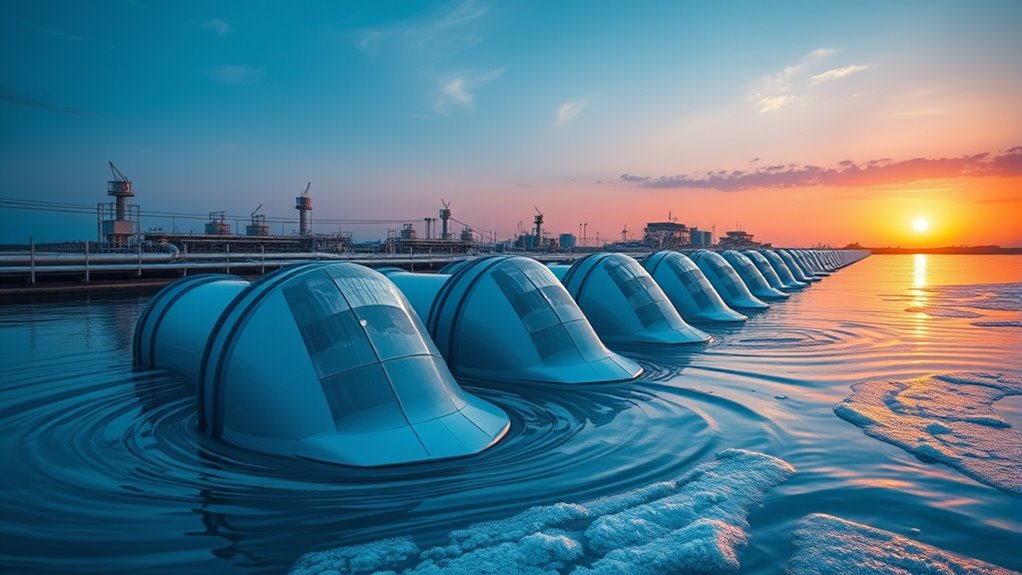Harnessing osmotic power lets you generate clean energy by capturing the natural movement of water from freshwater to seawater across salinity gradients. Using specialized membranes, this process converts the flow into electricity without harmful emissions, making it a sustainable and renewable solution. Since it relies on the Earth’s abundant water sources, it offers a continuous, environmentally friendly power source. To discover how this innovative technology works and its potential impact, explore further into its promising developments.
Key Takeaways
- Osmotic power generates renewable electricity by exploiting salinity differences between freshwater and seawater.
- It uses semi-permeable membranes to convert water flow into usable energy at salinity interfaces.
- The technology offers a continuous, eco-friendly energy source with zero greenhouse gas emissions.
- Advancements in membrane efficiency are crucial for making osmotic power cost-effective and scalable.
- Coastal regions with freshwater and seawater contact are ideal for harnessing osmotic energy.

Osmotic power, also known as salinity gradient energy, offers a promising way to generate renewable electricity by harnessing the natural movement of water from areas of low to high salinity. This process taps into the salinity gradient between freshwater and seawater, creating a flow that can be converted into usable energy. When freshwater and salty water meet, osmosis causes water to naturally move across a semi-permeable membrane, trying to equalize salinity levels. This movement produces pressure differences or flow, which you can harness with specialized turbines or membranes to generate electricity. The salinity gradient sits at the core of this process, acting as the driving force behind osmotic energy. Advances in membrane technology are crucial for improving the efficiency and scalability of osmotic power systems. You might think of osmotic power as a kind of natural pressure difference you can exploit, similar to how a dam works with water flow. Instead of water falling from a height, here, the energy stems from the difference in salt concentration. The challenge lies in efficiently capturing this energy, which requires advanced membrane technology and clever engineering. When designed properly, these membranes allow water to pass through while blocking salt ions, creating a flow that can be converted into electrical power. This setup resembles a natural battery, where the salinity gradient acts as the voltage source. The key advantage of osmotic energy is its sustainability. As long as freshwater and seawater exist, the salinity gradient persists, providing a continuous source of renewable power. Unlike solar or wind energy, osmotic power can operate around the clock without interruption, making it a reliable addition to the renewable energy mix. Plus, it produces no greenhouse gases or harmful emissions during operation, helping you reduce your carbon footprint. While the technology is still developing, several pilot projects demonstrate its potential to generate significant amounts of clean energy, especially in coastal regions where freshwater flows meet the ocean. You can see the promise of osmotic power in its ability to leverage an abundant, naturally occurring resource—water of varying salinity—without depleting or damaging ecosystems. As research advances and membranes become more efficient and cost-effective, osmotic energy could become a mainstream renewable energy source. By understanding and utilizing the salinity gradient, you open the door to a sustainable future powered by the very water that covers most of our planet. Harnessing osmotic power not only helps diversify your renewable energy options but also moves you closer to a cleaner, greener energy landscape.
Frequently Asked Questions
What Are the Main Technical Challenges in Osmotic Power Generation?
You face technical challenges in osmotic power generation, mainly ensuring membrane durability and managing the salinity gradient. Membranes often degrade over time due to intense osmotic pressure, reducing efficiency. Additionally, maintaining a consistent salinity gradient is tricky, as fluctuations can lower power output. Addressing these issues involves developing stronger, more resistant membranes and optimizing system design to handle variable water conditions effectively.
How Does Osmotic Power Compare Cost-Wise to Other Renewable Sources?
Think of osmotic power as a budding plant trying to break through the soil; right now, it’s not as cost-effective as solar or wind energy. Its economic feasibility depends on technology advances and scale, but currently, costs are higher. However, the market potential is promising in coastal areas with high salinity differences. As technology improves, osmotic power could become a more competitive, sustainable energy source.
What Environmental Impacts Could Osmotic Power Plants Have?
You should consider that osmotic power plants could cause marine pollution if not properly managed, potentially releasing harmful substances into water systems. Additionally, they might disrupt local wildlife, affecting fish and other marine organisms’ habitats. While they offer clean energy, it is crucial to evaluate and mitigate these environmental impacts to protect marine ecosystems and maintain biodiversity, ensuring sustainable and responsible energy production.
Are There Existing Large-Scale Osmotic Power Facilities Worldwide?
You might think large-scale osmotic power plants are common, but currently, only a few exist worldwide, mainly at experimental or pilot stages. The scale feasibility remains challenging due to high costs and technical hurdles, yet the environmental benefits—minimal emissions and renewable energy—make it a promising future technology. While not yet widespread, ongoing research aims to develop more efficient, larger facilities to harness this clean, sustainable energy source.
How Can Osmotic Power Be Integrated Into Existing Energy Grids?
You can integrate osmotic power into existing energy grids by connecting osmotic power plants to the grid through reliable grid integration systems. To manage variability, implement power storage solutions like batteries or pumped hydro, ensuring a steady supply. Collaborate with grid operators to balance loads and optimize energy flow. This approach allows osmotic power to complement other renewable sources, enhancing overall grid stability and providing clean, sustainable energy.
Conclusion
So, next time you think about saving the planet, just imagine turning ocean’s salty tears into sparkling clean energy. Who knew that mixing river water with seawater could generate enough power to run your coffee maker? It’s like inviting nature to a magic show—watching salt and water shake hands and produce electricity. Just think, the secret to powering your life might be hiding in the simple act of water swapping. Mother Earth’s little trick, right?









